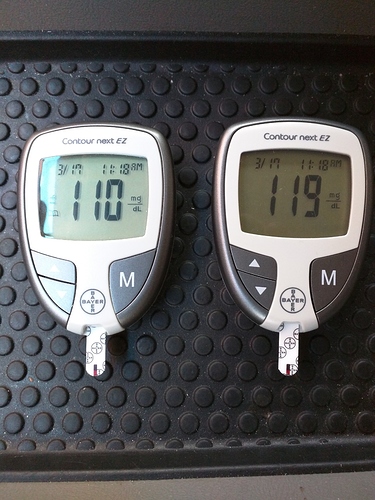Sano’s CGM post got my attention. Lately I’ve been experiencing elevation in BG and am starting an extended fast this morning. Tuesday or Wednesday I have a CGM (Abbott Freestyle Libre) coming in the mail. I will use the two week sensor and monitor.
My concerns in general are with instrumentation. My day job requires the use of instrumentation and gauges, and in my 12 years of experience dealing with measuring hydraulics, I have seen numbers all over the map, and have only seen extremely tight numbers with extremely expensive instruments.
Then there’s the additional complications of other variables occurring all over the map. And these variables are often never the focus. It’s only “OMG! My glucose is high!” or, “Yea! My BG is down this morning!” We’re pretty emotional people, I often find, and really look forward to celebrating the wins. But how accurate is the instrument? How much do we know about what’s going on in the bloodstream day in and out, hour to hour? What’s really happening? Can we tell this from a single BG reading at 5:30 am? Or just after fasting?
I have probably pricked my finger into the thousands, and have tons of data on spreadsheets to this regard. I’ve done many days on an hour to hour reading N of 1, to see what peaks and valleys happen, and on what fuels.
Here’s my concern. How can we really know that our meter is “accurate”? What is the gold standard? I’ve seen myself, for instance, that the TrueTest (and I guess, the True Metrix also) brands run considerably lower than my Bayer Contour Next EZ meter, at about 10-15 mg/dl lower. That’s important in terms of percentage. If my Contour Next is 110, then the TrueTest is 100. Which is “correct”? I’ve also seen some N=1s on the internet of diabetics measuring multiple meters, of different brands, with numbers all over the spectrum, to the point that it’s kinda dizzying.
So if I start having high numbers with my Bayer, I could just bury my head in the sand, grab the TrueTest, and truck along enjoying “lower” numbers for days. (laughter). A few days ago, I wanted to test the matter, and bought a second Bayer Meter. Two identical meters were off 10 mg/dl from one another. What to do? Do I buy a third?
It leaves me with the feeling of not much confidence in our meters. Or, perhaps to say it another way… at the end of the day, how do we really know what we know?
Some would say it doesn’t matter, that +/- of that range is insignificant. But it’s around 10%.
I suppose many would say that we should compare it to the “day of” while doing the blood draw at LabCorp. So, we’d say the lab with the centrifuge is the “standard”.
I’d love some feedback on this, because since we have no way of measuring insulin at home, with a fingerprick, the unfortunate surrogate is BG. Actually not a great surrogate at all, because one can have reasonable BG with high insulin. But nevertheless, it’s what we have.
So I guess I’m throwing out for discussion this whole topic of meter accuracy, and looking for some good ideas and feedback.
Thanks!



